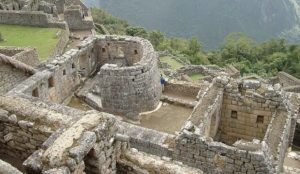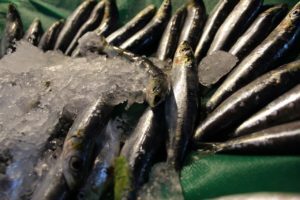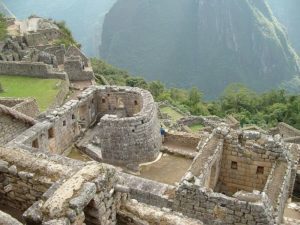
In 1865, the American archaeologist and diplomat Ephraim Squier, who would later provide some of the first descriptions of Inka ruins, landed on Peru’s North Coast. His ship’s crew rowed him ashore through a sluggish swell, passing over “a solid mass of the little fishes [anchovies] . . . which were apparently driven inshore by large and voracious enemies in the sea . . . The little victims crowded each other, until their noses, projecting to the surface, made the ocean look as if covered over with a cloak of Oriental mail. We could dip them up by handfuls and by thousands.” The belt of anchovies extended about a mile along the shore. Women and children scooped them up “with their hats, with basins, baskets, and the fronts of their petticoats.” Squier had arrived at one of the richest coastal fisheries in the world. Centuries earlier, these small fish helped create some of the most spectacular Pre-Columbian kingdoms in the Americas.
Ancient Bounty
The Peruvian anchovy (Engraulis ringens) live off larger zooplankton, among them krill and large copepods, and swim in enormous shoals in the upwelling waters of the Humboldt Current off the coast of Peru. Anchovies are small fish that live for three years and reach a maximum size of about 8 inches (20 centimeters). Today they are one of the most heavily exploited fish in the world. The bounty of the anchovy fishery is legendary. Extending over 1,250 miles (2,000 kilometers) from northern Chile to northern Peru, this strip of coastal water can yield as much as 100 tons of anchovies per square kilometer year after year. Today it produces more than one-fifth of the world’s commercially taken fish, a wealth rivaled only by the waters of the Benguela Current off Namibia in southwestern Africa. There are well known “hot spots” off Peru that can yield as much as 1,000 tons per square kilometer. Not surprisingly, the largest early monuments in Peru occur along the 375 miles (600 kilometers) of the coast bracketed by these hot spots. The most complex fishing societies arose where the fisheries were richest. At least in theory, the anchovy population in pre-modern times could support as many as six million people.
The anchovies feasted on zooplankton, sea birds thrived on anchovies and mollusks, and humans ate all three, except in El Niño years, when warm waters flowed over the cold and the anchovies moved elsewhere, followed by the birds. El Niños were unpredictable events. The more severe ones brought unfamiliar tropical fish to the coast, precipitating years of suffering when the people ate less fish, mollusks when they could find them, and whatever they could obtain on land.
____________________________________

Anchovies
____________________________________
People have been fishing on the Peruvian coast for a very long time, perhaps as early as 14,000 years ago. The earliest fisher folk moved between the interior and the coast, where they subsisted almost entirely on shallow water fish like drums. Almost certainly the fishers took their catches with nets. As proof, we have only a few fragments of what may have been nets and pieces of gourds that may have served as floats. They also foraged for surf clams, Mesodesma donacium, which grow in great abundance in the intertidal zone unless their habitat is disrupted by El Niño events. The resources of the coast were so easy to acquire that at some point before 6000 BC, permanent settlement replaced temporary encampments. Further, near the modern town of Ito, a permanent fishing village, known to archaeologists as the Ring site, flourished between 9200 and 3850 BC. The inhabitants lived off fish, sea birds, and sea mammals. The only terrestrial bones found at the site were those of four mice.
Far to the north, some thirty to forty people lived in a permanent settlement of dome-shaped, reed and grass houses at Paloma near Lima. These were serious fishers. Anchovies, sardines, and some larger fish appear in their dry middens, which also yielded fragments of fiber fishing nets and bone fish hooks. The clincher is their bone chemistry, which revealed very low strontium levels, a sign of an unusually high strontium component in the diet, which could have come from the Pacific. The Palomans relied on the land for their raw materials clothing, dwellings, nets, baskets, and fishing floats, as well as firewood for cooking and warmth. The land provided a simple infrastructure for effective fishing to the point that marine- and land-based economies were interdependent from very early times. This interdependence increased when inland societies began constructing major ritual centers and society grew more complex.
Invariably, fishing intensified as coastal populations rose. Along the Peruvian coast with its hot spots, fishers wove more nets and used reed canoes to gather ever-larger anchovy harvests. They could not have done this without growing cotton, a fiber with the rare ability to survive long exposure to seawater, which made it exceptionally useful for making fine-meshed nets. Mass harvesting of small fish intensified as cotton cordage and nets came into widespread use after about 2500 BC, when they switched from larger fish almost entirely to anchovies and sardines. At that time, coastal Andeans were growing far more plants for tool manufacture, such as cotton for net-making and gourds for floats, than for food.
The densest populations along the Pacific were at the backs of sandy beaches, where anchovy harvests were the largest. Some experts believe the coastal population may have grown as much as thirtyfold in the four centuries before 1800 BC, a time of massive construction projects along the coast, when local societies became less egalitarian and socially more complex. The explosive growth in human settlement in the valleys also resulted in some of the most elaborate irrigation systems in the ancient world. The Andeans began to cultivate maize, beans, chilies, squash, and other crops using carefully husbanded river floodwater, first in small-scale irrigation systems and later in much larger ones. Between 1800 and 400 BC, short and longer canals irrigated no less than 9,888 acres (4,100 hectares) of farmland. Once even small-scale irrigation came into common use and the proportion of plant foods in people’s diets began to rise, the dynamics of coastal life changed significantly. Food supplies, from the combination of the coastal fishery and river valley crops, became more reliable. Some coastal villages became specialist fishing communities, supplying fish as a commodity to the increasingly powerful inland centers.
The yield of the anchovy fisheries increased considerably with the development of coastal watercraft. Having no trees from which to build dugouts, the fishermen fashioned light canoes with sharply raised bows out of bundles of tied totora reeds, which abound close to shore and were used for thousands of years to build simple dwellings. Known today as caballitos de totora, “little reed horses,” these canoes ride low in the water, so an occupant can straddle it. The fisherman uses his legs to push off from the sand into the surf, where the high bow allows the totora to cut through swells into deeper water, where larger fish can be taken.
Once in deep water, several canoes would come together to lay fine, weighted gill nets that could catch thousands of anchovies and sometimes larger fish such as mullet. Once the gill net lay in place, individual fishers would have laid baited reed traps for lobster and other crustaceans or fished with hook and line. Judging from modern practice—some totaras are still in use—each fisherman would have had two canoes, one drying out on land to offset waterlogging while the other was in use. There is a remarkable similarity between the totora and the modern-day paddle board.
The enormous anchovy catches were dried, probably by laying them out on reed mats. As a product, dried anchovies and sardines had numerous advantages: they were easily caught and dried in enormous numbers, they were a reliable food source, and they were light enough to be carried inland in bulk, in baskets or nets on peoples’ backs, or in llama saddle packs. The new emphasis on anchovy and sardine fishing coincided with the development of large ceremonial centers and the expansion of irrigation agriculture. These large public works and the increasingly elaborate social and ritual environment required great numbers of people who were neither farmers nor fishermen. Workers laboring on adobe structures and those digging increasingly large-scale irrigation works all required rations.
Ruling Polities
How important were fish and other marine products in the emergence of Andean civilization? Generations of archaeologists have assumed that pre-industrial civilizations arose only when intensive agriculture was available to support rapidly growing urban populations. This assumption does not necessarily apply to the Peruvian coast and its associated river valleys, where major ceremonial centers and growing populations flourished before 2000 BC. Many years ago, the archaeologist Michael Moseley, working in the Ancon-Chillon area of the North Coast, documented the rapid pace of economic change after about 2000 BC. He pointed out that farming the desert required cultivated plants and knowledge of how to grow them, work forces to construct irrigation canals and field systems, and social institutions capable of organizing workers. The social mechanisms to build these large structures must have been already in place.
Long before they began irrigating river valleys, the people living along the Pacific had already built complex ritual structures that required large numbers of workers. The maritime economy supported this labor. There was no sudden change to farming. Instead, an increasingly powerful political authority arose to build and maintain elaborate ceremonial structures erected long before intensive floodplain agriculture. Moseley argues that this authority first came into being when fishing communities submitted willingly and voluntarily to some form of control. He believes that the unique maritime resources of the Pacific coast provided sufficient calories to support rapidly growing sedentary populations of non-farmers, clustered in increasingly larger communities on the coast and in inland river valleys. If Moseley is right—and his theory has survived a long time—then fish were the ultimate economic basis for the elaborate Andean state-organized societies that developed in later times.
The change can be seen in the quantities of fish brought ashore. Judging from modern yields, if ancient coastal populations had lived at sixty percent of the carrying capacity of the fisheries, and eaten nothing but small fish, the coast could have supported more than 6.5 million people. This does not, of course, mean that it did, but the figures show that the exploitation of small fish would have provided a more than adequate economic base for the emergence of complex societies.
Thus, although fishing didn’t by itself cause the rise of Andean civilization, it was certainly part of a cultural change that unfolded both in the Andes mountains and the Pacific lowlands over many centuries. The reliance on coastal resources led to the formation of large, densely concentrated coastal populations whose leaders were able to organize labor forces not only to build large ritual centers but later to transform river valleys with extensive irrigation works to grow cotton and gourds for nets as well as other crops. Under this scenario, irrigation agriculture was in the hands of a small, well-defined group with powerful religious authority, who took advantage of the existing simple technology and local populations to create new economies. This transformation, based on trade, maize agriculture—which reached the coast around 4500 BC—and a maritime diet, provided an impetus for radical changes in Andean society. But it depended on ancient fishing traditions that can be documented thousands of years earlier at early coastal villages.
The exponential growth in the size and complexity of coastal societies is apparent all along the nearly 400 miles (600 kilometers) where the richest fisheries lay. Dozens of ancient settlements in the Supe and neighboring river valleys, some 124 miles (200 kilometers) north of Lima, flourished between 3100 and 1800 BC. One of them, Caral, arguably the earliest city in the Americas, was occupied between about 2876 and 1767 BC. Six large mounds and at least thirty-two public buildings form the core of the city. Its Great Temple, a massive construction 30 meters high, has a large sunken circular court in front of it. The Peruvian archaeologist Ruth Shady Solis believes that Caral was the hub of a network of eighteen settlements in the Supe Valley that formed a cluster of major sites, along with numerous villages and smaller communities scattered along the edge of the valley. The central city of Caral is estimated to have absorbed more than a quarter of all the labor invested in the valley during these centuries. Many Supe Valley communities played specialized roles in the local network. Some were fishing villages. Caral and other Supe settlements were vulnerable to both major earthquakes and storms from El Niño events, both of which heavily damaged the main temple. The city was abandoned in about 1767 BC.
After 1800 BC, ever larger sites and ceremonial centers grew alongside the irrigation systems as society became more formalized. Farmers working under increasingly close supervision modified river valley landscapes for maize agriculture. Fishers became an anonymous background to elaborate, volatile river valley kingdoms. On the North Coast, the Moche state developed in coastal river valleys in two major regions, the Moche and the Lambayeque Valleys, between AD 200 and 800. The Mochica are best known for their spectacular warrior priest burials at Sipán in the Lambayeque Valley and for their magnificent ceramics and metallurgy. Their artists, masters of realistic portraiture, left us a vivid impression of a colorful society ruled by a wealthy elite. The rulers built spectacular temples, like the Huaca del Sol and Huaca de le Luna in the Moche Valley, which were settings for the kind of elaborate public ceremonies that tend to validate elite authority. Densely packed neighborhoods on the flat ground between the two great huacas (shrines) housed artisans who produced gold objects, textiles, and sophisticated ceramics. Exotic gold ornaments and fine cotton textiles passed from lowlands to the highlands, as did coastal products like seaweed, the only source of iodine for highland famers, who exchanged crops such as ulluco and potatoes for it.
The subsistence world of farming and fishing became overlain by the cut and thrust of elite politics and territorial ambitions. The Sicán dynasty, under a lord named Namlap, rose in about AD 750 to 800 and thrived for five centuries. By this time, water control and large-scale irrigation works were central to coastal subsistence, with fish providing a supplement that became especially important in El Niño years.
The Chimu, successors of the Sicán dynasty after about AD 900, developed a state that presided over the coast from the Moche Valley to the Lambayeque. Their leaders ruled from Chan Chan, a sprawling city that covered more than 7.7 square miles (20 square kilometers). This was a controlling domain, which governed not only valley towns and irrigation schemes but outlying villages that grew cotton and edible crops, or caught large quantities of fish. At their height, Chimu farmers had 30 to 40 percent more land under cultivation than is farmed today. Everyone, fisher, farmer or artisan, was part of a much larger enterprise. Chimu rulers were careful to maintain strategic monopolies on the trade of key exotics and other commodities. Nowhere is this more apparent than at Cerro Azul, an important fishing community of the Warku kingdom, 75 miles (130 kilometers) south of Lima. Here, tens of thousands of anchovies were harvested, dried, and traded to inland farmers, and perhaps even farther afield.
In 1470, the coast became part of the vast Inka empire, Tawantinsuyu, “The Land of the Four Quarters”, which came into being through conquest in a century or less, spanning highland and lowland environments from the Lake Titicaca region to Ecuador. The Inka were accomplished warriors and brilliant organizers who used both administrative skill and draconian force to hold their empire together. Now the coastal fisher folk served remote masters.
The Inka erected an imposing stone fortress overlooking Cerro Azul. The local economy became a highly organized production line based on the anchovy fishery, whose harvests far exceeded the supplies needed to feed the locals. Thousands of anchovies and sardines were dried, packed tightly into storage rooms, and covered with dry sand to preserve the harvest. They were inventoried and taxed by ubiquitous officials with their quipus, knotted strings used to record numbers. The volume of the trade must have been enormous. Some idea of the numbers of people involved comes from contemporary descriptions of a polity in the neighboring valley to the south, home to 12,000 farmers, 10,000 fishers, and 6,000 merchants.
The Inka empire collapsed in the face of the Spanish conquistadores, but, as usually happened in history, the ancient rhythms of field and fishery continued unchanged. People have to eat. Anchovies passed by the basket- and wagonful into Lima and other cities. But the fishery was still pre-industrial, much of it conducted in small wooden boats or from reed canoes identical to those of earlier times. It may have yielded millions of fish and significant weights of fishmeal, used, like bird guano, as fertilizer, but now it was for purely local markets. Five centuries were to pass before anchovies and guano would become two main staples of the Peruvian economy, a status that anchovies would maintain until industrial-scale fishing brought about the collapse of one of the richest fisheries in the world.
____________________________________

The great Inka city of Machu Picchu
____________________________________
Readers can find out more about the role of fishing in laying the foundations of civilizations all over the world in Brian Fagan’s new book, Fishing, published by Yale University Press.
____________________________________


